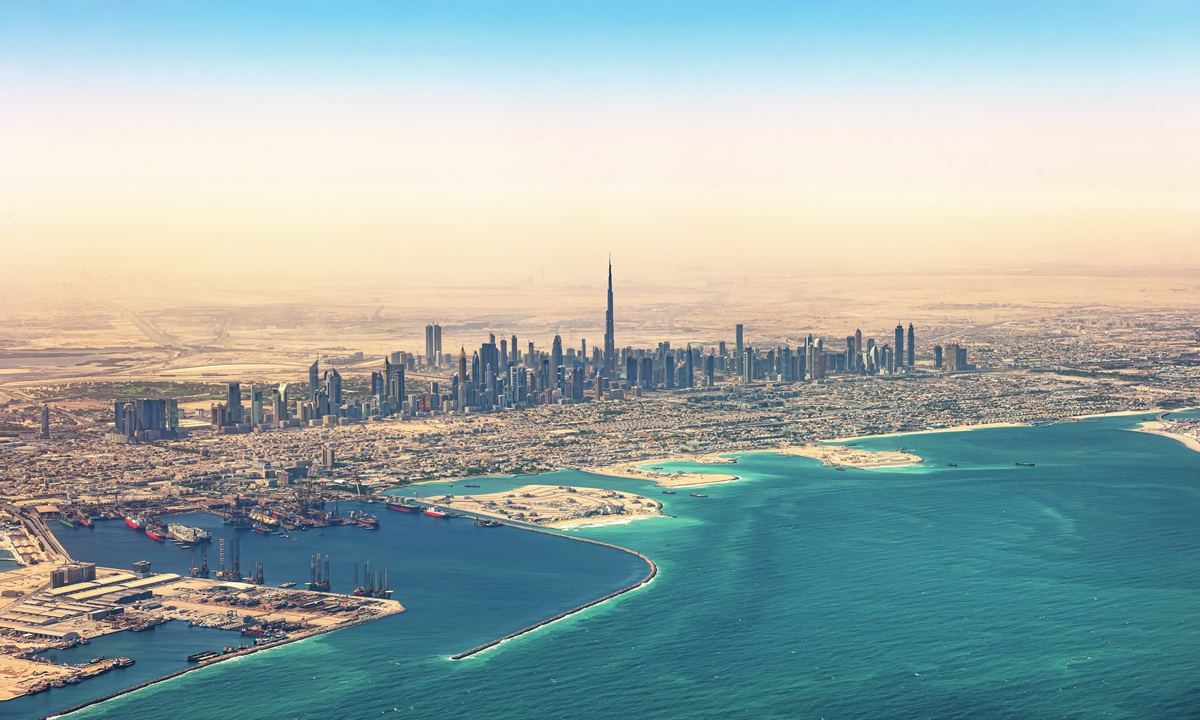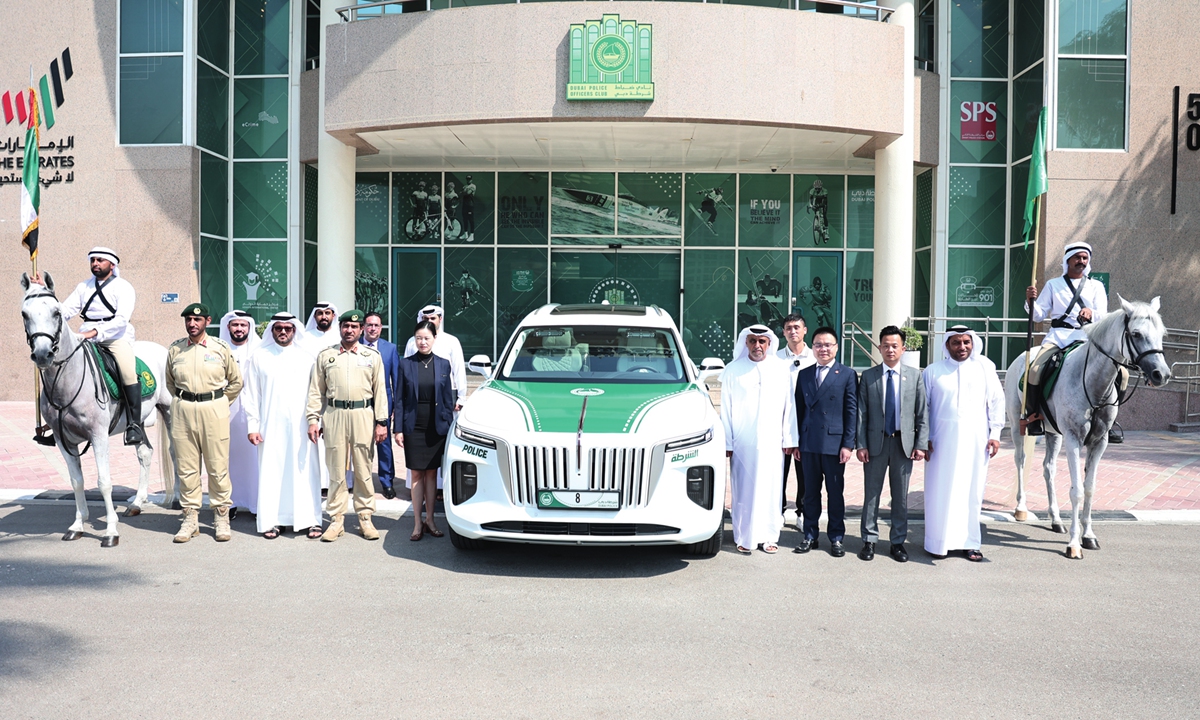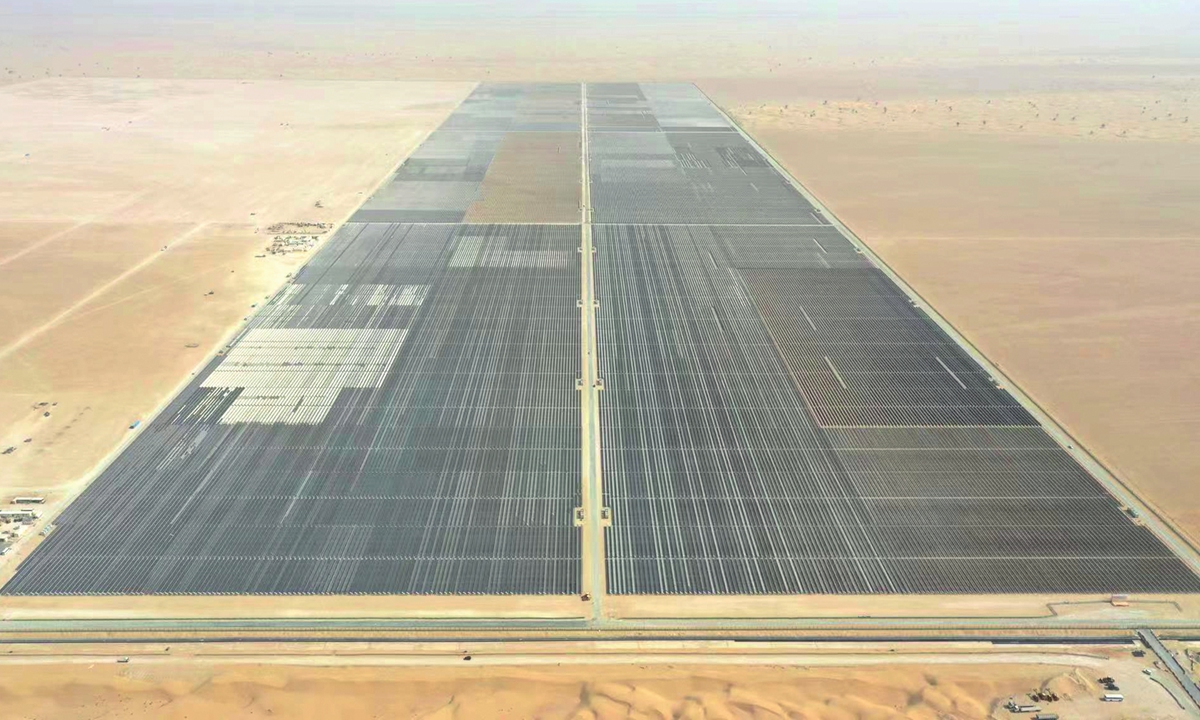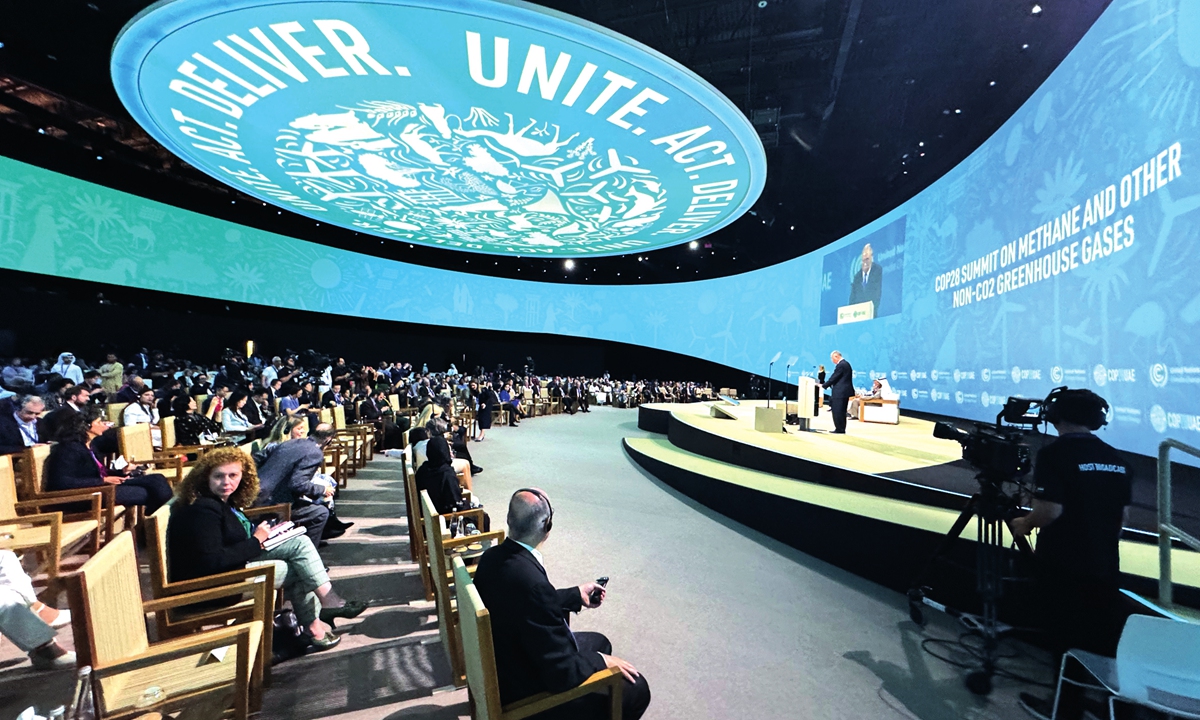
The skyline view of Dubai Photo: VCG
The on-going COP28 in Dubai, the UAE, a conference dedicated to green and low-carbon practices, has also showcased Chinese brands' efforts in global environmental conservation.
Since the start of the conference, Chinese brands such as Higer and BYD have provided electric shuttle bus services to ferry attendees, with about 50 electric vehicles from South China's Guangdong Province offering shuttle services in the conference's "Green Zone," which is open to the public.
This is just a microcosm of the vigorous development of China's new-energy industry on display in the UAE.
The UAE Energy Strategy 2050 aims to increase the share of clean energy projects to 50 percent of its overall energy mix by 2050. Moreover, countries like Saudi Arabia and Egypt have similar goals and visions.
In September 2020, China proposed its goals to peak carbon emissions by 2030 and achieve carbon neutrality by 2060, with top-down societal involvement.
The development of Chinese industries around new energy, including new-energy vehicle (NEV) and photovoltaic unit manufacture, ranks highly in the world and aligns with the transformational development path of the Middle East.
During COP28 in Dubai, the Global Times visited and interviewed some Chinese new-energy enterprises operating in the UAE to understand cooperation efforts in the new-energy field between China and the UAE and how Chinese technologies and products are driving the carbon reduction process in the Middle East.
Rising starIn October 2022, Dubai police held a grand induction ceremony to welcome the new Hongqi E-HS9 police cars from China as additions to the existing police car fleet. Not only were leaders from both Dubai police and Hongqi in attendance at the ceremony, but a ceremonial guard on horseback was also held.
Dubai boasts an all-star police car fleet almost entirely comprised of super sports and luxury vehicle brands, from Ferrari and Lamborghini, to Bentley, and now a Chinese brand.
More notably, Hongqi's high-level debut marks the first independent automotive Chinese brand to join the Dubai police fleet and also the first NEV brand globally to do so.
Dubai also awarded the first Hongqi (EHS9) the prestigious number plate "8," as a sign of respect and recognition.
Local police leadership praised Hongqi's local development and expressed high appreciation for the partnership, wishing the development of Hongqi cars in the UAE and the world well. They said the entry of Hongqi into the Dubai police car fleet is a manifestation of the friendly development of relations between the two countries, with an anticipation for a longer and deeper relationship between China and the Arab world.
It was Oneroad Group Dubai, a Chinese company, that introduced the Hongqi brand to the UAE.
"We decided to introduce Hongqi cars not only because we saw the continuous improvement in independent Chinese-brand car technology but also recognized the reliable strength of China in making electric cars," said Zhang Chenling, Acting Chief Executive Officer at the Oneroad Group Dubai, to the Global Times at the company's offices at the Burj Khalifa.
"We have been making deep inroads in the UAE for more than a decade and believe that we have the capability to introduce Chinese-brand cars into the UAE market," Zhang explained.
Hongqi is a well-known automotive brand in China with a long and glorious history. It was the first high-end sedan to be manufactured in-country since the founding of the People's Republic of China in 1949. Hongqi, meaning "red flag" in Chinese, used to be served as the ride of top government leaders, which also had been used as parade cars during National Day parades.
According to Xie Qiyi, General Manager of Oneroad, the group doesn't only represent the Hongqi brand in the UAE. Following the commencement of the Belt and Road Initiative (BRI), the company also focuses on the overseas services offered by other Chinese automotive brands, such as Dongfeng Forthing and Great Wall Motors in the UAE, Oman, as well as in other countries and regions.

Dubai police officers and representatives from Oneroad Group Dubai pose with a Hongqi E-HS9 police car. Photo: Courtesy of Oneroad Group Dubai
At an automotive sales center near Dubai's Business Bay, the Global Times saw Hongqi and Forthing NEVs on prominent display.
Karam, a local resident, had his eye on a new arrival - a Forthing Friday EV. "The car is spacious, the interior is luxurious, and it has a sense of technology," Karam told the Global Times.
Pan Kuibai, a manager at the sales center, told the Global Times that Chinese NEVs have certain market potential in the Middle East, not only because Chinese technologies and products have received increased recognition in recent years, but also because the Middle Eastern market is not prejudicial against Chinese products or prone to imposing political restrictions as is the case with some Western countries.
"Overall, even though these cars are not cheap due to their high configurations, they are still favored by the locals," he said.
According to China Energy News, China's NEV industry chain is attracting the attention of Middle Eastern oil giants. Preliminary statistics show that since the beginning of 2023, NEV industry chain companies such as NIO, HiPhi, and Pony.ai have successively gained the attention of Middle Eastern capital.
Industry insiders believe that as the world's largest NEV market, China's advantages in product technology and industry chain completeness have attracted considerable investments from Middle Eastern capital. Combined with the energy transformation needs of Middle Eastern countries, cooperation and exchanges between Chinese enterprises and Middle Eastern countries in the high-quality NEV sector will deepen and broaden further in the future.
Zhang from Oneroad also stated that as the UAE continues to vigorously and rapidly promote energy transformation and carbon reduction, 50 percent of the country's official and public vehicles will also be replaced with NEVs, which will bring opportunities for Chinese enterprises. "Although local supporting facilities still have much room for development, significant changes will be seen within a few years," she said.
Sharing sunshineIn recent years, the Middle East has witnessed increased advocacy in the diversified development of energy, utilizing its unique sunlight conditions to vigorously develop photovoltaic projects and optimize the electricity energy structure. Against this backdrop, China's leading photovoltaic industry enterprises have targeted local opportunities here and hope to seize the development initiative.
A large-scale Chinese-built photovoltaic power station, which looks particularly spectacular from the air, calls the desert suburbs of Dubai home.
The synchronization of Shuaa Energy 3 900MW PV project is a recent representative project of China's leading photovoltaic enterprise Sungrow in Dubai. According to Thompson Meng, Vice President of Sungrow PV & BESS BG, Sungrow has large landmark projects in Dubai and Abu Dhabi, in the UAE, as well as in Qatar, Oman, and Saudi Arabia, radiating into North Africa's Egypt, Morocco, and Algeria.
Observers noted that in some countries participating in the BRI, green infrastructure such as new-energy and information networks will see rapid growth in the future. Among them, the photovoltaic industry chain will become the most developmentally advantageous sub-sector of China's new-energy cooperation abroad.
In terms of the region, the Middle East has the greatest potential for photovoltaic demand, and it is expected that by 2025, the export of photovoltaic components to the Middle East may account for more than 10 percent of China's total export volume of photovoltaic components, Yicai reported.

The synchronization of Shuaa Energy 3 900MW PV project in Dubai Photo: Courtesy of Sungrow
According to the Securities Times, many Chinese photovoltaic enterprises are also actively taking root in Saudi Arabia and other countries.
Meng introduced that in addition to abundant light energy and vast land, the policies of governments in the Middle East are also relatively supportive. "They are thinking about transitioning from traditional fossil energy resources to new-energy and future technology manufacturing, so these policies and strategies are very supportive of this industry."
As a leading enterprise in the industry, Meng noted that Sungrow has a 26-year history, with dynamic technology, having undertaken the long arduous journey of development, surmounting challenges, and achieving great results, which now allows the company to export its expertise overseas. In addition, the enterprise has always been forward-looking, engaging in long term planning, and insists on sustainable development amid intense global competition.
Against the backdrop of China striving to achieve its dual-carbon goals and the global response to climate change, Meng also believes that Chinese enterprises, especially those leading the new-energy industry, are taking on their social responsibilities.
"For energy transformation, you need to play a leading role, not just focus on short-term interests. This industry is one that benefits humanity. Whether from the perspective of pollution reduction or carbon reduction, it has a positive significance," he said. "Also, our enterprise needs to focus on cultivating talents with such a vision and mindset, which I think is also a great contribution to society."
Chinese powerDuring the first days of the COP28, Sultan al-Jaber, the COP28 President, as well as the UAE Minister of Industry and Advanced Technology announced that more than 110 governments have pledged to triple the world's renewable energy capacity by 2030 at the COP28 climate summit. It also included a target to double the global rate of energy efficiency by 2030.
This year's COP has attracted more than 80,000 participants, making it the largest UN climate summit in history. In addition to the Chinese delegation, many institutions, enterprises, and observers from China participated in the conference and set up pavilions, holding related events to provide a platform for participants from various countries to engage in exchanges and understand China's carbon reduction measures and achievements.

The 28th Conference of the Parties to the UN Framework Convention on Climate Change (COP28) held in Dubai, the UAE Photo: Shan Jie/GT
For instance, the All-China Environmental Protection Federation also set up the Solar+ Pavilion (Photovoltaic Corner) in the Blue Zone of COP28 with LONGi Green Energy, showcasing the development and innovation of the photovoltaic industry and providing a platform for people of different identities to discuss and achieve energy equity.
Additionally, research institutions such as the China Automotive Technology and Research Center Co Ltd, also held a side event on NEVs and low-carbon transportation at the China Pavilion during COP28, inviting guests from the UN, the UAE, and China to learn about possible cooperation between China and the UAE in new-energy industries.
Analysts said that investments in China's NEV technology by Middle Eastern countries signify a strategic shift toward energy transformation and the finding of new competitive edges in emerging industries. Meanwhile, they emphasized the importance of market-specific adaptations and risk management for Chinese automakers exporting to the Middle East, and the consideration of local climate and consumer preferences.
Zhou Wenjun contributed to this story







